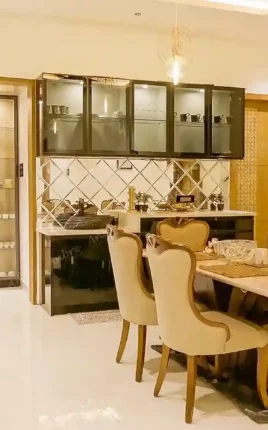Library Units
Library units are essential in home interior design, offering both practical storage and an impressive display for your books and collections.
These units are designed to house and showcase your books, magazines, and decorative items with style and functionality. Modern library unit designs focus on efficient space usage, with customizable shelves and compartments that adapt to your needs.
Customizable Personalized Library Units for Your Literary Collection
Elegant library units for stylish storage. Adjustable shelves and modern designs enhance any room. Perfect for organizing books and décor with sophistication.
Integrated Library
Industrial Style Library
Reading Nook Library
How can you transform your living room's design?
Benefits of a Well-Designed Pooja Unit
- Organized Storage: A thoughtfully designed library unit provides ample shelving to neatly arrange books, magazines, and decor, keeping your space clutter-free.
- Aesthetic Appeal: Enhances the look of your home with stylish wooden or modern shelving that complements your interior design.
- Space Efficiency: Whether built-in, wall-mounted, or freestanding, a library unit optimizes space while offering easy access to your collection
FAQs About Best Home Interior Design
A library is a collection of books, magazines, and other informational resources organized for reading, research, and reference. Libraries can be found in homes, schools, universities, and communities. Having a library provides several benefits:
- Access to Knowledge: Libraries offer access to a wealth of information on various subjects, promoting continuous learning and education.
- Organized Space: A dedicated space for books and resources helps keep your home or institution organized and clutter-free.
- Inspiration and Relaxation: Libraries create a serene environment conducive to reading, studying, and relaxation.
- Cultural and Community Hub: Public libraries serve as community centers, offering programs, workshops, and events that bring people together.
In a home setting, a library can be a quiet retreat for personal study and enjoyment. In a community, it serves as an essential resource for education and cultural enrichment.
There are various types of libraries, each serving different purposes and audiences:
- Home Libraries: Personal collections of books and resources, typically organized in a designated room or space within a home.
- Public Libraries: Community libraries open to the general public, providing access to books, digital media, and various programs.
- School Libraries: Libraries within schools that support the curriculum and provide resources for students and teachers.
- Academic Libraries: Found in colleges and universities, these libraries offer extensive collections for research and academic study.
- Special Libraries: Libraries that cater to specific industries or fields, such as medical libraries, law libraries, and corporate libraries.
- Digital Libraries: Collections of digital resources, including e-books, journals, and databases, accessible online.
Each type of library is designed to meet the specific needs of its users, providing tailored resources and services.
Choosing the right size for your home library involves considering several factors:
- Available Space: Measure the area where you plan to set up your library. Ensure there is enough room for bookshelves, seating, and any additional furniture or equipment you may need.
- Collection Size: Assess the number of books and resources you currently have and plan to acquire. Choose a size that accommodates your existing collection and allows room for growth.
- Functionality: Think about how you will use the space. Will it be primarily for reading, studying, or a combination of both? Ensure there is enough space for comfortable seating, adequate lighting, and work surfaces if needed.
- Aesthetic Preferences: Consider the overall design and layout of your home. The library should complement your existing décor and create a cohesive look.
When planning your library, don’t forget to account for future additions to your collection. It’s helpful to visualize the space using a digital room planner or by marking out the dimensions on the floor with tape.
Choosing the right size for your home library involves considering several factors:
- Available Space: Measure the area where you plan to set up your library. Ensure there is enough room for bookshelves, seating, and any additional furniture or equipment you may need.
- Collection Size: Assess the number of books and resources you currently have and plan to acquire. Choose a size that accommodates your existing collection and allows room for growth.
- Functionality: Think about how you will use the space. Will it be primarily for reading, studying, or a combination of both? Ensure there is enough space for comfortable seating, adequate lighting, and work surfaces if needed.
- Aesthetic Preferences: Consider the overall design and layout of your home. The library should complement your existing décor and create a cohesive look.
When planning your library, don’t forget to account for future additions to your collection. It’s helpful to visualize the space using a digital room planner or by marking out the dimensions on the floor with tape.
Library furniture is available in a variety of materials, each offering different benefits in terms of durability, appearance, and cost:
- Wood: Solid wood shelves and furniture, such as oak, walnut, or teak, offer durability and a classic look. Wood can be finished in various stains to match your décor.
- Metal: Metal shelving and furniture provide a modern, industrial look. They are durable and can support heavy loads, making them ideal for larger collections.
- Glass: Glass shelves or tables can add a touch of elegance to your library. Tempered glass is recommended for its strength and safety.
- Laminate and Veneer: Laminate and veneer finishes offer a wide range of colors and patterns, making it easy to match your furniture to your room’s décor. They are also more resistant to scratches and stains than natural wood.
- Upholstery: For seating, consider upholstered chairs or sofas that offer comfort and style. Choose durable fabrics that are easy to clean and maintain.
When selecting materials, consider the overall style of your home, your budget, and the level of maintenance you’re willing to commit to. Each material has its own care requirements, so choose one that fits your lifestyle.
Organizing your home library effectively enhances both functionality and aesthetics. Here are some tips to help you get started:
- Categorize Books: Group similar books together by genre, author, or subject. This makes it easier to find what you need and keeps the library looking tidy.
- Use Shelving: Install bookshelves that can accommodate books of various sizes. Adjustable shelves allow you to customize the height to fit different types of books.
- Labeling: Consider labeling shelves or sections to help keep your collection organized. This is especially useful if you have a large number of books.
- Display Decoratives: Use open shelves or display cases for special editions, decorative items, or personal memorabilia. This adds a personal touch to your library.
- Seating and Lighting: Ensure there is comfortable seating and adequate lighting in your library. Task lighting, such as reading lamps, is essential for reading and studying.
Regularly review and reorganize your library to ensure it continues to meet your needs. As your collection grows, adjust the organization to accommodate new books and maintain a neat, functional space.
Yes, many aspects of a home library can be customized to match your specific requirements and preferences. Customization allows you to create a space that perfectly fits your needs and style. Here are some aspects you can customize:
- Bookshelves: Choose the size, material, and finish of your bookshelves. Custom shelving can be designed to fit specific wall dimensions or to create unique configurations.
- Furniture: Select custom furniture, such as reading chairs, desks, or tables, that match your style and provide the functionality you need.
- Lighting: Install custom lighting solutions, such as built-in bookcase lights or adjustable reading lamps, to enhance the usability and ambiance of your library.
- Storage Solutions: Add custom storage solutions, such as built-in cabinets, drawers, or hidden compartments, to keep your library organized and clutter-free.
- Décor: Personalize your library with custom artwork, rugs, or decorative items that reflect your taste and interests.
When considering customization, work with a reputable carpenter or interior designer who can guide you through the process and ensure the final result meets your expectations. Custom libraries may take longer to complete and can be more expensive than ready-made options, but the result is a unique space that perfectly suits your needs and style.
- Regular Dusting: Use a soft cloth to dust bookshelves, furniture, and books regularly. This helps prevent dust buildup and keeps the library looking clean.
- Avoid Harsh Cleaners: Use mild soap and water for cleaning furniture. Avoid using harsh chemicals or abrasive cleaners, as these can damage the finish. For wooden furniture, use a furniture polish designed for wood.
- Book Care: Handle books with clean hands and store them upright on shelves. Avoid stacking books horizontally for extended periods, as this can damage the spines.
- Check for Damage: Regularly inspect your library for any signs of wear and tear, such as loose shelves, scratched surfaces, or damaged books. Address any issues promptly to prevent further damage.
- Climate Control: Maintain a stable temperature and humidity level in your library to prevent damage to books and furniture. Avoid placing bookshelves in direct sunlight, as this can fade book covers and weaken bindings.
- Open Shelving: Open shelving creates a modern and airy look, making it easier to access and display books. It also allows for creative arrangements and decorative touches.
- Multi-functional Spaces: Libraries are increasingly being designed as multi-functional spaces that can serve as reading nooks, home offices, or even entertainment areas. This trend maximizes the usability of the space.
- Integrated Technology: Incorporating technology, such as built-in charging stations, smart lighting, and integrated sound systems, enhances the functionality and convenience of the library.
- Eco-friendly Materials: Sustainable and eco-friendly materials, such as reclaimed wood and non-toxic finishes, are becoming popular choices for library furniture and shelving.
- Bold Colors and Patterns: Bold colors and patterns are being used to create visually striking libraries. This trend adds personality and vibrancy to the space.
- Explore current trends here.
- Space Optimization Experts: Parallel layouts utilize every inch of your long, narrow space, creating a highly functional workspace.
- Double the Countertop Power: Enjoy ample counter space on both sides, perfect for spreading out while you prep and cook.
- Streamlined Workflow: The parallel design minimizes wasted steps, promoting an efficient layout with everything within easy reach.
- Unleash Your Design Vision: Personalize your dream kitchen with a wide range of cabinet styles, finishes, and appliances.
Explore the Possibilities:
Looking for inspiration or expert advice? We offer a comprehensive collection of:
- Parallel Kitchen Design Ideas: Discover stunning designs and layouts to spark your creativity.
- Indian Parallel Kitchen Interior Design: Explore beautiful examples that blend functionality with Indian aesthetics.
- Small Space Parallel Kitchen Design Images: See how to maximize every inch of your space with clever design solutions.
- Parallel Modular Kitchen Designs: Discover the benefits of pre-fabricated units for a smooth installation process.
- Parallel Kitchen Cabinet Design: Explore a variety of cabinet styles and storage options to perfectly suit your needs.


